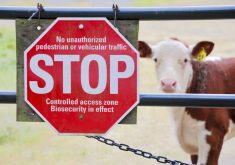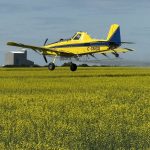Farmers are at the front line of disease identification, a role that’s not always recognized.
Why it matters: Infectious diseases pose a risk to animal and human health, farm production and have trade implications.
“I think this year has shown us why we pay attention to infectious diseases,” said Dr. Scott Weese, professor at Ontario Veterinary College, University of Guelph.
Read Also

Ontario’s agri-food sector sets sights on future with Agri-Food 2050 initiative
The first-ever Agri Food 2050, a one-day industry event dedicated to envisioning the future of food and farming in Ontario,…
At the virtual Grey Bruce Farmers’ Week, Weese said farmers have little control over the border controls and industry standards relating to the importation of live animals, food and animal products. But they do have control over what happens on their farm.
Weese said a farmer who has a disease on their farm hasn’t necessarily done anything wrong, but how they react is important.
“We want to motivate people to get help,” he said. “The more we start blaming people, stigmatizing people when they’ve got a disease issue, the less impetus there is for people to get help and to report.”
It’s important to periodically reassess farm protocols and look for areas of improvement, he said.
He suggested that if the “to do” list has 10 things that can’t all be managed, at least do two of them.
“Two is better than zero,” Weese said. “We can never eliminate the risk of infectious diseases and new diseases, but there are things we can do to mitigate that risk.
“The reason I want to pay attention to how things get here is because I want to figure
out how I can stop that from happening,”
he said.
“African swine fever is probably not going to be diagnosed by a researcher or someone who’s doing surveillance, or an academic swine vet,” he said. “It’s going to be identified by someone on a farm.”
African swine fever (ASF) could have potentially devastating economic and animal health impacts on the Canadian livestock sector mirroring that of mad cow disease, (bovine spongiform encephalopathy or BSE) if gets into the country.
“From an economic impact this is probably our doomsday virus for Canada with food animals,” said Weese. “One infected animal, one infected farm is going to shut the export markets down right there and they’re not opening for quite a while.”
It would cost billions, which is why it’s better to overreact than underreact when an unusual pattern reveals itself on the farm, said Weese.
At the farm level, Weese said preventive measures could be initiated around feeding practices, travellers, wildlife, moving animals, people and food — anything that can cross between farms or countries where risk is created.
“Most often strange things that happen are just strange occurrences of normal things, common things occur commonly,” he said. However, if a vet hears the same strange incident on four or five different farms, that could indicate the emergence of an issue.
There is little farmers can do about inadvertent importation of insects or migratory birds, outside of on-farm protocols to minimize risk and exposure.
Ticks an increasing concern
For example, ticks are an increasing concern for disease transmission and impact on animal health as climate change has allowed them to survive overwintering in Ontario. Weese said no one is expecting a producer to tick check 1,000 head of cattle, but being tick aware and reducing exposure will help.
The Asian long-horned tick, although not currently in Canada, could eventually pose a threat to livestock, wildlife and companion animals. The female can lay 2,000 eggs without fertilization from a male, turning one tick on an animal into thousands fairly quickly and, because of its voracious appetite, it can impact production and growth and even kill a cow.
It has been found in parts of the United States.
“If you’re seeing ticks, it’s worth figuring out what kind of ticks those are. We really want to know about this tick.”
Producers tend not to disclose on-farm issues in the belief it will likely get better with time or a fear of being judged.
However, this information is highly valuable for early detection and as a proactive tool against disease and virus control, said Weese.
Weese said there are veterinarians, specialists and researchers willing to offer advice, or suggest testing for any disease or virus concern.
As well, farmers can turn to organizations such as the Canadian Food Inspection Agency, Ontario Ministry of Agriculture, Food and Rural Affairs, Ontario Animal Health Network and the public.
“Hope is not your infection control strategy,” he said. “What we do to prevent and control emerging diseases is usually very similar, if not the exact same thing, that we do to prevent our normal diseases. The key is reaching out early.
“Everyone can do something. For me it’s a matter of being prepared, which doesn’t mean doing a lot,” he said. “It’s just having good practices and good biosafety measures, being willing to communicate, not panicking but not under-reacting and get help early.”















